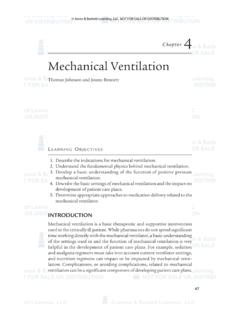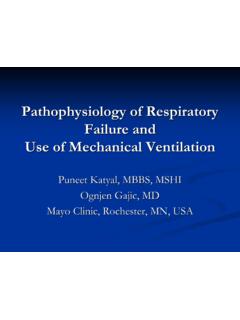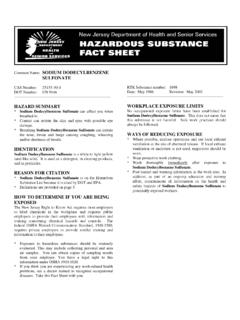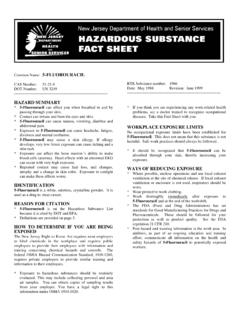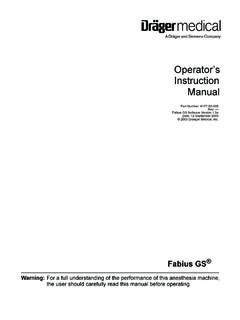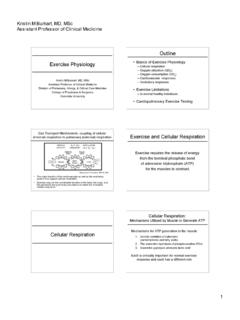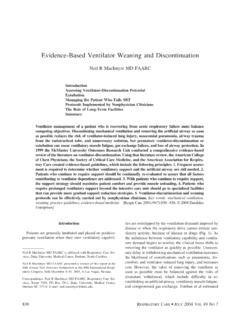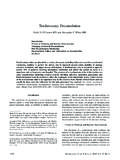Transcription of Abnormal Ventilation, Abnormal Exchange
1 Abnormal ventilation , Abnormal Gas Exchange Robert C. Basner, MD. Associate Professor of Clinical Medicine Director, Adult Pulmonary Diagnostic Unit Director, Cardiopulmonary Sleep and Ventilatory Disorders Center Columbia University College of Physicians and Surgeons ventilation and Gas Exchange ventilation and Gas Exchange Objective: to achieve adequate tissue oxygenation j q yg and remove metabolically produced CO2. ventilation : concerned with delivery of fresh volume of air to gas exchanging units, and the removal of a f h d h l f sufficient volume of mixed gas out Gas Exchange : the ability to move gas across the Gas Exchange : the ability to move gas across the alveolar capillary membrane ventilation and Gas Exchange ventilation and Gas Exchange The failure of either or both results in impaired p arterial blood gases and ultimately respiratory failure. Ventilatory failure: l f l Hypercapnic respiratory failure f l Gas Exchange failure: Hypoxemic respiratory failure Hypoxemia is the inevitable result of both H i i th i it bl lt f b th ventilation ventilation = Breathing ventilation Breathing ventilation ventilation is the process of moving gases is the process of moving gases between the atmosphere and the alveoli Normal breathing Normal breathing Respiratory rate = the number of breaths per minute About 12 to 15 per minute Abbreviated RR.
2 Tidal volume = volume of gas inspired in a single breath About liters Abbreviated VT. Minute ventilation = volume of gas inspired per minute = RR x VT. About 6 liters per minute Abbreviate VE. Only Some of the Tidal Volume Reaches Alveoli h l l A t i Dead Anatomic D d Space . S . Alveolar Space . Dead Space Dead Space Anatomic Dead Space Anatomic Dead Space Normal About 1ml per lb. body weight (. About 1ml per lb body weight (~150. 150 ml). ml). Physiologic Dead Space Physiologic Dead Space Abnormal Areas not participating in gas Exchange (more later). A t ti i ti i h ( l t ). Dead Space Dead Space VT = VD + VA. 500 ml = 150 ml + 350 ml Alveolar and Dead Space ventilation Alveolar and Dead Space ventilation VT = VD + VA. VT RR = (VD RR ) + (VA RR ). & & &. VE = VD + VA. Volumes and flows Volumes and flows Total and Alveolar ventilation Total and Alveolar ventilation PACO. & & &. VCO2 = VA FACO2 = VA 2. K. V&CO2 V&CO2. V&A = K K. PACO2 PaCO2.
3 Total and Alveolar ventilation Total and Alveolar ventilation P CO. V&CO2 & &. = VA FACO2 = VA A 2. K. V&CO2 V&CO2. V&A = K K. PACO2 PaCO2. Total and Alveolar ventilation Total and Alveolar ventilation P CO. V&CO2 & &. = VA FACO2 = VA A 2. K. V&CO2 V&CO2. V&A = K K. PACO2 PaCO2. Total and Alveolar ventilation Total and Alveolar ventilation P CO. V&CO2 & &. = VA FACO2 = VA A 2. K. V&CO2 V&CO2. V&A = K K. PACO2 PaCO2. Application of the Alveolar ventilation Equation l l l &. VCO2. PaCO2 . V& A. What happens if . 1. Dead space increases (minute ventilation held constant). 2. Minute ventilation increases (VD is constant). 3. CO2 production increases PaCO2 is used to determine alveolar ventilation l Normal PaCO2 = 37 to 42 mm Hg Normal PaCO2 = 37 to 42 mm Hg PaCO2 > 42 mm Hg = alveolar hypoventilation PaCO2 < 37 mm HG = alveolar hyperventilation CO2 3 G l l h il i Hypoventilation Hypoventilation Decreased minute ventilation (decreased RR and/or VT).
4 Alveolar Hypoventilation Inability Inability to inspire and expire a volume of air/gas sufficient to meet to inspire and expire a volume of air/gas sufficient to meet metabolic demands Inabilty to bring a fresh volume of O2 with each breath to the gas exchanging unit, and inability to remove CO2 2 produced by metabolism Alveolar hypoventilation can only result from one or both of the following: Hypoventilation Increased dead space fraction (dead space/tidal volume ratio). I dd d f i (d d / id l l i ). Increased PAO2 (hypercapnia) indicates the presence of alveolar hypoventilation Some Causes of Hypoventilation 1,2 Depression of the respiratory center by drugs, injury, tumor, etc. 3 Ab 3. Abnormalities liti off th the spinal i l cord d (( , ffollowing ll i hi high h di dislocation). l ti ). 4. Anterior horn cell disease ( , poliomyelitis). 5. Diseases of the nerves to the respiratory muscles ( , Guillain-Barr ). 6 Diseases of the myoneural junction (e 6.)
5 ( , g myasthenia gravis). 7. Diseases of the respiratory muscles ( ,muscular dystrophy). 8. Thoracic cage abnormalities ( , crushed chest). 9. Upper airway obstruction ( , tracheal compression by the thymoma). Causes of Alveolar Hypoventilation Causes of Alveolar Hypoventilation Neuromuscular insufficiency (previous slide). Neuromuscular insufficiency (previous slide). Respiratory muscle fatigue A prolonged increase in the work of breathing will A l di i th k f b thi ill lead to respiratory muscle fatigue Common cause of hypercapneic respiratory failure Common cause of hypercapneic respiratory failure We We will come back to alveolar hypoventilation will come back to alveolar hypoventilation during our discussion of hypoxemia Hypoxemia Definition of Hypoxemia Definition of Hypoxemia Low partial pressure of O. Low partial pressure of O2 in blood (PaO. in blood (PaO2) ). OR Low O. O2 content (CaO. (C O2). Ca O 2 = ( Hb Sa O 2 ) + ( Pa O 2 ).)
6 Hypoxemia Hypoxia yp yp Hypoxia is metabolic O. yp 2 deficiency y Hypoxia causes are: stagnant , as with impaired blood flow; histocytoxic ,as with metabolic impairment using O2, such as cyanide poisoning; hypoxic . hypoxic , as with impaired oxygenation such as low V/Q, as with impaired oxygenation such as low V/Q. or low PIO2 such as high altitude;. anemic , as with low Hgb or carbon monoxide poisoning Hypoxemia Anemia Hypoxemia Anemia Anemia is low hemoglobin g Low hemoglobin decreases the O2 carrying capacity of the blood CaO2. Hypoxemia Low O2 Delivery Hypoxemia Low O. O2 delivery depends on delivery depends on O2 content cardiac output di t t & O = C O CO. D 2 a 2. The Alveolar Gas Equation is used to Characterize the Mechanisms and Severity Characterize the Mechanisms and Severity of Hypoxemia PI O2 = FiO2 ( PB PH 2O ). PACO2 (1 R). PAO2 = PI O2 + PACO2 FI O2 x ]. R R. PACO2. PAO2 PI O2 . R. Alveolar Gas Equation Alveolar Gas Equation PACO2 PaCO2.
7 PAO2 PI O2 PI O2 . R R. PACO2=PaCO2. R=Respiratory Exchange Ratio: (gas R=CO2 added to alveolar gas by blood/amount of O2 removed from alveolar gas by blood; low V/Q=low R); normal= AaDO2 and Hypoxemia and Hypoxemia The The difference between predicted P. difference between predicted PAO2 and and measured PaO2 is called the alveolar arterial oxygen gradient or A a gradient , abbreviated AaDO2. Normal AaDO2 ~ 10 15 mmHg in young adult at sea level breathing room air (RA). Normal AaDO2. Normal AaDO. PA O 2 = 100. Pa O 2 = 90. AaDO2 = 100 - 90 = 10. Normal AaDO2 = 10-15 mmHg in young adults at sea level breathing RA. Normal AaDO2. Normal AaDO. Room air: Room air: PI O2 = FiO2 ( PB PH 2O ). PaO2=90 mmHg PaCO2=40 mmHg =40 mmHg PI O2 = (760 477) = 150. 50. pH= PaCO2. PAO2 PI O2 . R. 40. PA O 2 150 = 100. 0 .8. Physiologic Causes of Hypoxemia Physiologic Causes of Hypoxemia No widening of AaDO2. Hypoventilation Low PIO2. may contribute to widening if impaired diffusion Widening of AaDO2.
8 V/Q mismatch Shunt Diffusion Abnormality Alveolar Hypoventilation Alveolar Hypoventilation Increased Increased PPAO2 2 (hypercapnia) indicates the (hypercapnia) indicates the presence of alveolar hypoventilation Clinical pearls Clinical pearls Does not widen the AaDO2. The hypoxemia may be readily ameliorated with Th h i b dil li d ih supplemental O2. Challenge: Write a proof for this latter statement Challenge: Write a proof for this latter statement PaCO2. PAO2 PI O2 . Case History Case History R. Room air: Room air: PI O2 = FiO2 ( PB PH 2O ). PaO2=30 mmHg PaCO2=90 mmHg =90 mmHg PI O2 = (760 477) = 150. 50. pH= PaCO2. PAO2 PI O2 . R. 90. PA O 2 150 = 37 . 5. 0 .8. Case History Case History PA O 2 = 37 . 5. Pa O 2 = 30. AaDO2 = 30 = Normal AaDO2 = 10-15 mmHg in young adults at sea level breathing RA. PaO2 and AaDO. and AaDO2 at altitude at altitude Patm = 250 mm Hg at 50 g PI O2 = FiO2 ( PB PH 2O ). PaCO2 = 18 mm Hg R = 1 R 1 PI O2 = (250.)
9 50 477) = 433. Recent data PaCO2. a t tude 8 00. altitude 8400m PAO2 PI O2 . PaO2=30 mmHg R. AaDO2 mmHg 18. wider than expected PA O 2 43 = 25. Grocott et al, NEJM 2009, 1. 360;2: 141. 360;2: 141. Case History Case History Room air Room air PaO2=70 mm Hg PaCO2=30 mmHg PaCO2=30 mmHg No treatment (RA). PaO2=50 mmHg PaCO2=28 mmHg What happened? PaCO2. PAO2 PI O2 . Case History Case History R. Room air Room air 30. PA O 2 150 = 112 . 5. PaO2=70 mm Hg 0 .8. PaCO2=30 mmHg PaCO2=30 mmHg AaDO 2 = 112 . 5 70 = 42 . 5. No treatment (RA). PaO2=50 mmHg PaCO2=28 mmHg What happened? PaCO2. PAO2 PI O2 . Case History Case History R. Room air Room air 30. PA O 2 150 = 112 . 5. PaO2=70 mm Hg 0 .8. PaCO2=30 mmHg PaCO2=30 mmHg AaDO 2 = 112 . 5 70 = 42 . 5. No treatment (RA). PaO2=50 mmHg 28. PA O 2 150 = 115. PaCO2=28 mmHg 0 .8. What happened? AaDO 2 = 115 50 = 65. Physiologic Causes of Hypoxemia Physiologic Causes of Hypoxemia No widening of AaDO2. Hypoventilation Low PIO2.
10 May contribute to widening if impaired diffusion Widening of AaDO2. V/Q mismatch Shunt Diffusion Abnormality Low V/Q. Low V/Q. Low relationship of V to Q. Low relationship of V to Q. Some alveoli are underventilated . Low V/Q is NOT. Low V/Q is NOT low ventilation of all low ventilation of all alveoli That would be alveolar hypoventilation Alveolar PO2 and PCO2 across various V/Q relationships / l h O2 CO. CO2 diagram showing a V/Q ratio line diagram showing a V/Q ratio line PAO2 = 40 PAO2 = 100. PAO2 = 150. PACO2 = 45 PACO2 = 40. PACO2 = 0. V/Q = 0 V/Q = V/Q = . (dead space) (shunt). Examples of V/Q mismatch Examples of V/Q mismatch Most parenchymal lung diseases cause hypoxemia by p y g yp y altering V/Q matching Examples Asthma COPD. Pulmonary Fibrosis Pulmonary Fibrosis Pulmonary Edema Diffusion Abnormality Diffusion Abnormality Alveolar capillary thickening p y g pulmonary hypertension pulmonary vasculitis pulmonary embolism Alveolar destruction (emphysema).










